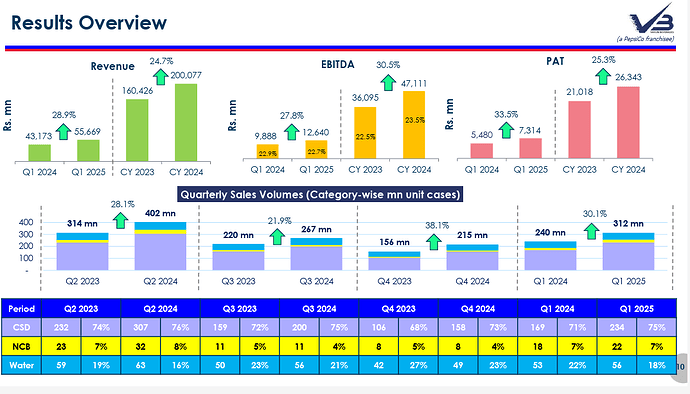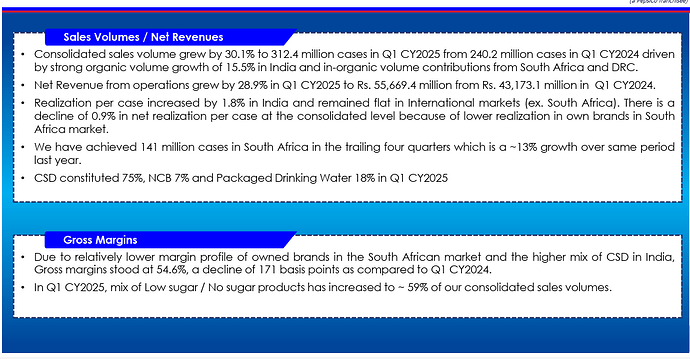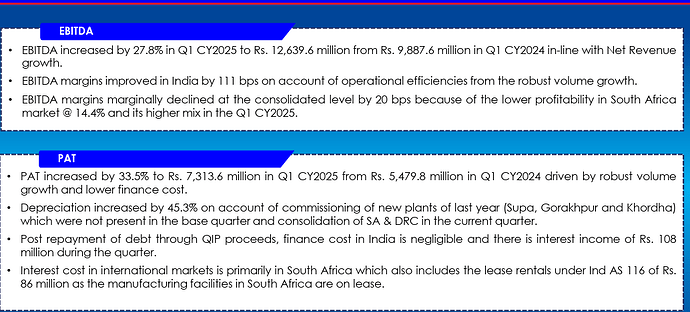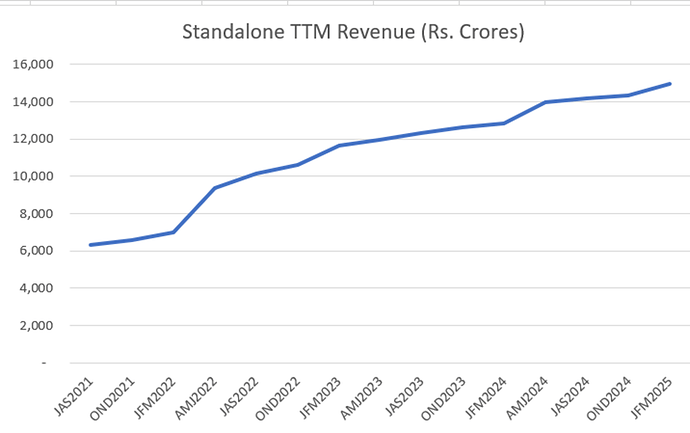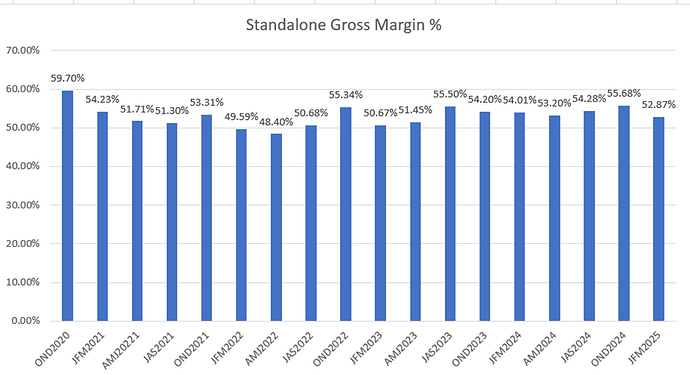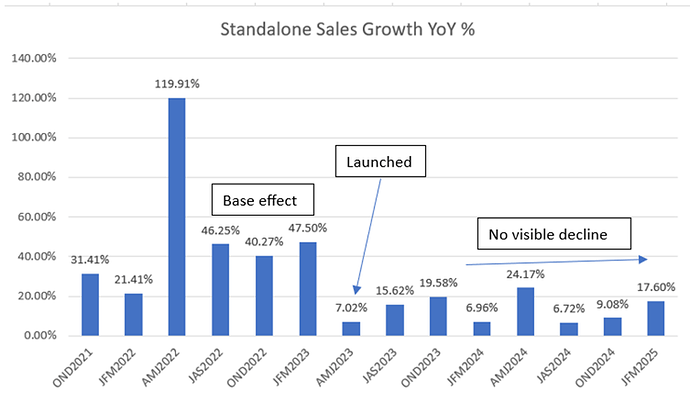Here are potential red flags or areas of caution from Varun Beverages’ Q1 CY2025 financial results:
 1. Decline in Gross Margin
1. Decline in Gross Margin
- Gross Margin fell to 54.6%, down by 171 basis points YoY.
- Indicates rising input costs, unfavorable mix, or pricing pressures.
- Management did not elaborate on reasons—needs clarity whether due to sugar, PET resin, or energy costs.
 2. EBITDA Margin Compression
2. EBITDA Margin Compression
- EBITDA Margin decreased by 20 bps YoY to 22.7%, despite revenue and volume growth.
- Implies cost pressures not fully offset by higher sales.
- Margin decline during volume growth phase could signal operational inefficiencies or inflationary strain.
 3. Increase in Other Expenses
3. Increase in Other Expenses
- Other expenses rose from ₹3,405.5 mn (Q1CY24) to ₹4,615.9 mn (Q1CY25).
- A 35.5% increase, faster than revenue growth (29.2%).
- May include higher distribution, logistics, or promotional spend – but breakdown not provided.
 4. Capital Expenditure & Investments
4. Capital Expenditure & Investments
- Heavy capex continues: new Prayagraj plant and ₹22.4 mn solar power investment.
- While expansion is positive long-term, debt levels and return on new assets need to be monitored.
- No clarity on how quickly the Prayagraj facility will ramp up or contribute to profits.
 5. Low Disclosure on International Operations
5. Low Disclosure on International Operations
- VBL operates in multiple countries (e.g., Africa), but segmental/geographic revenue data is not provided.
- Limits visibility into risks from currency fluctuations, political exposure, or regulatory challenges.
 6. Inventory & Working Capital Watch
6. Inventory & Working Capital Watch
- Not disclosed in detail in this report, but rising sales with margin compression can cause working capital stress.
- Full balance sheet was not part of this release—investors need to look at quarterly cash flow data when available.
Any way to assess what the total installed capacity is and at what utilisation is the same running?
Seems this info is not available as part of their published reports
Company Has acquired 50% stake of Everest Industrial Lanka (Private) Limited.(company in Sri Lanka )
At cost of INR 320.88 Million.
This company engaged in the business of production, manufacturing, distribution and selling of commercial
visi-coolers and related accessories.
4320eb05-d1c0-4fa1-9de3-c1dc4a0dc93b.pdf (2.3 MB)
For most of the last year, the discourse around Varun Beverages has been dominated by just one topic – what effect Campa would have on its business. This summer would have decided that question once and for all, but that is not going to happen. The peak season has been a complete washout for the cola companies.
Without waiting for the quarter results, and at the risk of being called premature, let us therefore look at what – if any – effect Campa has had on VBL’s business so far. And whether the numbers justify the extreme pessimism we have seen in the analyst commentary for more than year now.
We should look at the standalone financials of VBL.
As per the Q1 CY25 results, the company reported organic volume growth of 15.5 % in India while revenue growth was 17.60 %. Realisation per case improved 1.8 %. EBITDA margins improved by 111 bps, while PBT has grown by 42.41 % YoY. This sounds fine, but this was for the last quarter alone. We should see the trend.
Effect of competition and price war if any should show up in lower realisations or lower volume / revenue growth and depressed margins.
Campa was formally launched on 9th March 2023. From thereon, it would take a few quarters for Reliance to improve distribution and increase penetration. The Campa effect if any should gradually begin to be seen somewhere from late 2023 onwards.
Let us look at VBL’s revenues first.
Revenues have continued to rise, and stood at Rs.4053 crore in Q1 CY25 against Rs.3446 crore last year. TTM revenues rose further to Rs.14,955 crore.
Then, margins.
Gross margins have remained steady over the years and stood at 52.87 % in for Q1 CY2025. This is down from 54.01 % last year but still higher than 2022 & 2023. They have always hovered around the 52-53 % range. No decline here.
Finally, the Growth Rate.
Growth rate YoY has been fluctuating but there is no visible declining trend. Note that the exceptionally high growth seen in CY2022 was due to a low base of Covid in 2021 plus the benefit of new territory acquisitions in the South & West coming on stream. We are only interested in seeing whether growth is slowing as Campa gradually expands. But there is no such trend.
If competition was pinching, it should have shown up somewhere in the numbers. But data shows Varun Beverages has not seen much damage so far at least.
Both Pepsi & Coke have responded to the Campa challenge partly with price cuts and partly by flooding the market with smaller unit packs. Smaller packs make price differential between competing products less important in customer’s purchase decision, letting other factors like habit, brand familiarity and taste prevail.
I see merit in the management’s argument that as prices fall, market expands. We can see this in most of the discretionary consumption and indulgence products. For example, when fuel prices fall or milage improves, people drive more and buy bigger cars. Cheaper mobile phones have led people to buy better models, and cheaper data has meant more surfing. Same thing should happen in beverages as well, if one accepts that for most of the Indian consumers, cola is still an ‘indulgence’ product.
One good thing I notice is that Reliance has bigger ambitions. It has launched Campa in the UAE & Bahrain, plans to setup a plant in Saudi Arabia and expand into Africa and Southeast Asia. This shows Reliance is interested in growing its own business rather than play a zero-sum game and just try to defeat the incumbents in India. This is good for the industry. So long as the market is growing, this strategy poses much less of a threat to the incumbents in India.
The summer had started well with above average temperatures in end-March / early April. But later the weather – like Trump – took a complete U-turn and what we ended up with was the rainiest May we have ever seen. We never got that One Big Beautiful Summer we wanted to see. The cola giants have been forced to call a ceasefire. Investors now have no choice but to wait for one more year to see who trumps whom. Until then,
Thank you for your attention to this matter!
(Disc.: Invested)
Some important pointers on industry development
-
Pepsi and Coca-Cola were competing on price even before Campa’s entry. They reduced the price of 12-Rs packs to 10 (Glass botle). Then, Campa entered aggressively at 10Rs with PET, significantly increasing pricing pressure.
-
35% of the CSD market is in the 10-20Rs price point. Campa has not affected larger pack sizes (750ml+) yet.
-
Coke and Pepsi increased volume from 250 ml to 400 ml in the 20-rupee.
-
Initially, Campa struggled but leveraged nationalist sentiments, positioning as an Indian alternative, which helped penetration. Campa then matched the taste profile of established brands like Thums Up in cola and tapped into the orange segment, which Pepsi & Coke less prioritized.
- In India, Lemon is the biggest category with a much larger SKU mix, followed by Cola.
-
-
Market share
-
Campa’s market share is sub ~2-3% in select markets like TN, Telangana, penetrating markets dominated by local B-brands (45% market in TN is from B-brand).
-
Coke has lost significant market share in WB to Campa due to 10Rs pricing; Pepsi’s losses are very low. In UP, Pepsi’s market loss is very low vs Coke, because Dew has little direct competition. Thumbs Up is most affected.
-
Campa attempted to replicate Dew’s taste in North but failed. Coke & Pepsi haven’t matched Campa’s trade margins yet.
-
-
Cooler replacements are <1% across markets, esp in South India. Instead, Campa is installing coolers in smaller, less-prominent outlets not penetrated by major brands.
- Coke & Pepsi dominate visi-cooler installations (about 2:1 ratio, coke/pepsi). There is room for growth beyond Tier-2/3 cities, but low rural consumption and high distribution costs impact rapid expansion.
-
Horeca mix is ~30% to industry sales overall. Different by region: ~25-30% in TS/AP, ~45% in Mumbai.
Distributor and retailer margins
-
Campa offers higher trade margins than Pepsi and Coke. Campa gives 130 margin per case (30 bottles x 10 Rs), while Coke/Pepsi gives ~90-100.
- Of 130, wholesalers typically retain 25-35 per case and pass on 95-100 to retailers, much higher than what Pepsi/Coke offers.
Distribution & Geographic penetration
-
Campa faces distributor issues. Distributor churn is high (~65-70%), due to operational challenges. Sustainable growth and repeat sales remain low due to these inefficiencies.
-
Opex in the soft drink industry avg 14-15 per case, making distribution economically challenging, esp for low-priced 10Rs products. Campa lacks a direct distribution system and is heavily reliant on wholesalers (~80% dependency).
-
The South is not a big Coca-Cola market except for Andhra and TS. Coke has invested significantly in Visi-coolers, and Pepsi is catching up.

